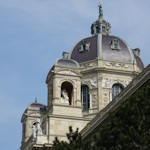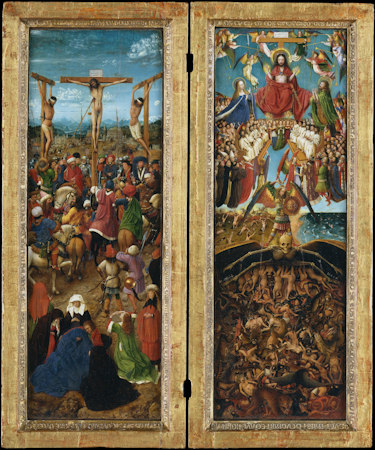
Vienna’s Kunsthistorisches Museum (KHM) often showcases pioneers and gamechangers in art history. The new “Als Ich Can” Jan van Eyck exhibition continues the habit…
- Two-room exhibition includes three rare original van Eyck works
- Other period works on display, too
- Runs Jul 10, 2019 – Jan 6, 2020
- See also:
- KHM tickets and visitor info
- Selected past exhibitions at the KHM
- Current art exhibitions in Vienna
van Eyck in Vienna

(An example of Jan van Eyck’s work: The Crucifixion; The Last Judgment, ca. 1440–41. Now displayed in the Metropolitan Museum, who kindly provided this image)
Scholars credit the Flemish painter, Jan van Eyck (1380/1390 – 1441), with various significant contributions to the development of painting forms and techniques. He helped pioneer oil as a medium, for example, and works like The Arnolfi Portrait have achieved iconic status.
Van Eyck also initiated the era of Netherlandish painting that yielded such gems as Hieronymus Bosch and paved the way for the likes of Bruegel. So we can reliably describe him as one of art history’s influencers from a time when the label required more than an ability to pout on Instagram.
Only around twenty original van Eyck paintings survive today, which makes any exhibition of his works a rarity and a treat.
Thanks to the efforts of the Kunsthistorisches Museum in Vienna and curator Sabine Pénot, in collaboration with the Flanders delegation to Austria, we can see three of the paintings in a new Jan van Eyck exhibition:
- The almost postcard-sized Madonna and Child at the Fountain from 1439, on loan from the Royal Museum of Fine Arts in Antwerp
- The portrait of Jan de Leeuw from 1436, where the portraiture technique parallels a 1433 van Eyck painting considered by many to be a self-portrait
- The Portrait of a Scholar, perhaps the papal diplomat, Cardinal Albergati, from around 1435
Van Eyck produced most of his work under the aegis of Duke Philip the Good (1396 – 1467) of the Burgundian Low Countries. I suspect the Duke may have been a little more amenable than van Eyck’s previous aristocratic employer, the Duke of Bavaria-Straubing (known as John the Pitiless).
As well as escaping the historical record with an excellent moniker, Philip presided over one of the more acclaimed eras of medieval civilisation and art. You can see his prayer book diptych in the exhibition.
Quite apart from having van Eyck as court painter, our Burgundian Duke also founded, for example, the Order of the Golden Fleece. This exclusive chivalric order enjoyed a long association with the Habsburgs; the order’s rich paraphernalia often appear in Habsburg portraits.
The van Eyck exhibition includes one of the order’s 15th-century vestments: a gold and silk chasuble (the outermost, largely sleeveless, vestment worn, for example, by priests when celebrating mass). The Imperial Treasury houses more of the order’s insignia and collars of office.
Other items featured in the exhibition include one or two once misattributed to van Eyck, such as the St. John altarpiece or a work by the workshop of Rogier van der Weyden.
Incidentally, if you’re a fan of van Eyck, almost half of his surviving works will be part of a special exhibition in Ghent in 2020, itself part of a wider van Eyck year in the city with numerous highlights.
Dates and tickets
The van Eyck exhibition runs from July 10, 2019 to January 6, 2020. No special ticket is required for the exhibition, just a normal entrance ticket.
The exhibition itself is in the Kunstkammer part of the building.
How to get to the Jan van Eyck exhibition
Reaching the Kunsthistorisches Museum is easy, given its central location. See here for details.
Address: Burgring 7, 1010 Vienna | Website